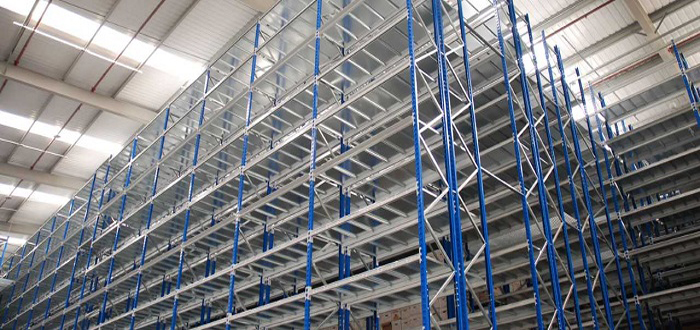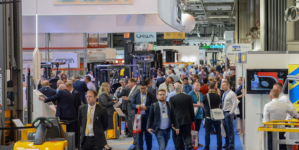-
ROSSLARE EUROPORT TARGETS HEALTH & SAFETY WITH CAMERA TELEMATICS PARTNERSHIP - 2 days ago
-
Landmark Study Reveals Wearable Robotics Significantly Boost Safety and Efficiency in Industrial Environments - July 24, 2024
-
Visku Tackle The Retail Seasonality Challenge One Pallet At A Time - July 22, 2024
-
KAMMAC AND BERGEN LOGISTICS STRENGTHEN FASHION & LIFESTYLE SERVICES IN THE UK - July 19, 2024
-
TENTBOX EXTENDS PARTNERSHIP WITH ARROWXL TO SUPPORT INCREASING DEMAND - July 17, 2024
-
The Perfume Shop improves customer journeys while driving profitability in partnership with Scurri - July 17, 2024
-
ZEROMISSION SECURES £2.3M ($3M) INVESTMENT TO ACCELERATE ELECTRIC FLEETS - July 16, 2024
-
BCMPA CELEBRATES SUCCESS OF 2024 CONFERENCE - July 15, 2024
-
Best of the Best: Jungheinrich Celebrates Triple International Award Win - July 12, 2024
-
GOPLASTICPALLETS.COM CALLS ON NEW CHANCELLOR RACHEL REEVES TO CONSIDER PLASTIC PACKAGING TAX REFORM - July 10, 2024
Why Storage, Not Staff, Is The Key To Competing With Amazon
Jeff Bezos’ divorce, a trillion dollar valuation, a new U.S. headquarters, staff protests. You just can’t keep Amazon out of the news, and 2018 was a busy year even by their standards. While not all of the stories were positive, Amazon’s status as the head of the pack when it comes to online shopping keeps everyone talking – and means everyone wants to know their secrets.
Much has been made over the years of their ruthless streak in terms of staff turnover, and the ways in which they seek to eke out greater performance from their warehouse and logistic staff. For the many eCommerce and logistics companies trying to compete with them, it can be tempting to take this as a mandate to try the same tactics. But is this reasonable, or simply a misreading of the situation?
Unbelievable, Jeff
There are a million and one articles to be written on how Amazon came to power, and then went on to conquer the globe. Some of the story is very simple: great timing and execution. Bezos formed his business when the premise of eCommerce was still conceptual, and jumped in as soon as the technology existed to make it work. Steady expansion on an international scale and diversification of products allowed him to ride out the dotcom bust, and the company also made successful gambles on web services and cloud storage. In short, it got into a number of lucrative niches early, expanded quickly, and got the jump on its bricks and mortar rivals.
While the company’s earlier expansion is fairly easy to explain, its ascent to the biggest company in the world requires a bit more digging. Bezos has showed no signs of slowing down over the years, and Amazon has looked to aggressively consolidate its position by making its operations as efficient as possible. Perhaps the most public aspect of this has been its efforts to optimise distribution through the management of staff, many of whom are temporary or seasonal workers.
Some staff have complained that conditions in Amazon’s warehouses are poor, with targets so excessive that workers have been reprimanded for toilet breaks. Amazon for its part has responded to complaints and strikes by raising wages, but shows little sign of changing its methods. Its latest efforts to boost efficiency include augmented reality glasses, which will track the precise movements and technique of workers to assess their efficiency, as well as providing them with picking data through a heads-up display.
Labour pains
Faced with the prospect of competing with Amazon, some eCommerce companies have opted to follow their lead, and look to increase efficiency by increasing the demands on employees. The rise of the gig economy and zero-hours contracts have arguably incentivised this kind of strategy, with it being more readily accepted to only employ staff based on demand, and to have a high turnover of manual labour. In order to get close to Amazon’s one-day and even same-day delivery – one of the chief selling points of Amazon Prime – this is seen as necessary.
What this perhaps fails to appreciate is that these kinds of improvements are the ones making headlines today. The horror stories about staff are the result of Amazon and other companies trying to squeeze the last remaining drops of productivity improvements out of their business. Their approach to labour is a consequence of their drive to maintain and improve their position, and not necessarily the thing that got them to that point.
The things Amazon did well to begin with are still relevant to any business, and they don’t require you to potentially make your employees unhappy. Watching the market and making canny bets; offering a service that nobody else offers, and doing it better than anyone else. Working with other partners and building deals to add value to your platform, and treating customers the right way. All of these things are more inclined to bring back customers and clients, and form the bedrock of a successful business.
Super storage
Of course, this doesn’t mean that you can’t improve the efficiency of your warehouses too – but there are far better ways to do it. While Amazon may have exhausted most other avenues, most businesses have not tried the other solutions to this problem. Chief among them is the storage you use in your warehouse, and how this facilitates speedy storage, picking and distribution. A more intelligent and efficient storage solution can make your whole operation faster, and make your employees happier to boot.
For the purposes of an eCommerce operation, this might include converting to a multi-tier system. Multi-tier racking provides an ideal compromise between accessibility and density, increasing storage volumes while improving picking speeds. Multiple operatives can access the pick faces in a multi-tier system at the same time, using walkways to navigate through racks. This allows for much faster hand-picking than a traditional storage system, while still accommodating both small goods and pallets.
Alternatively, you might consider an even more Amazon-like alternative – an automated storage and retrieval system (AS/RS). An AS/RS automates the bulk of the storage and retrieval process, with a series of shuttles, cranes or lifts depositing different SKUs in the appropriate bays, and retrieving them as requested. With the addition of conveyors and even robots, you can all but eliminate the human element in the process. Specialised warehouse management systems (WMS) can communicate these incoming orders and deliveries faster than a human could manage, ensuring everything runs smoothly.
While automation is already an active part of many warehouses, it is expected to advance quickly over the coming years. For a canny business, this will allow not for the elimination of labour, but the transfer of resources to other areas. Instead of manual labour, an automated warehouse might feature a much smaller number of high-skilled workers, with a broader set of responsibilities. The person in charge of supervising the WMS might also be involved in data science, analysing the data it collects and applying their knowledge to improve the process.
Whether you choose to stick with present-day storage solutions or experiment with automation, there are significant gains to be had by simply upgrading your storage solution, and making the picking and storage process more efficient. Doing so won’t just lead to space and cost savings; it can also make your employees’ lives easier, giving them the motivation to work hard and stay with the business. Fostering that work ethic and experience – two qualities which built Amazon – will benefit you far more than copying what they’re doing today.
James Beale is the Operations Manager at Invicta Pallet Racking. For over 25 years Invicta has been at the forefront of the archive storage industry throughout the UK and Europe, designing and installing some of the largest pallet racking systems currently found on the market.

































